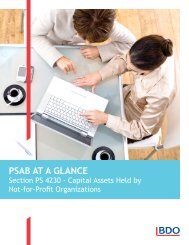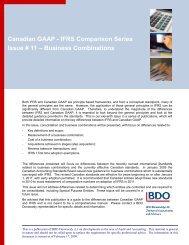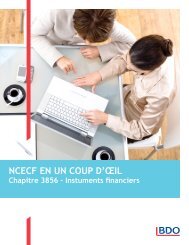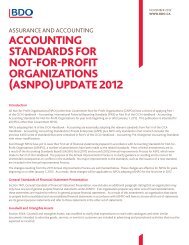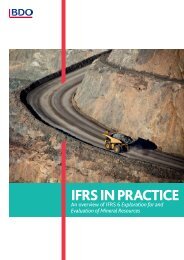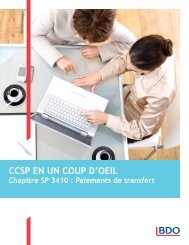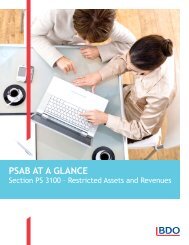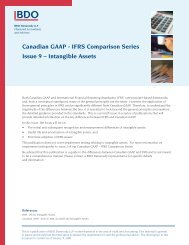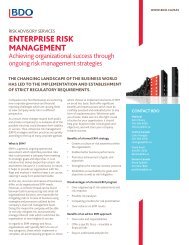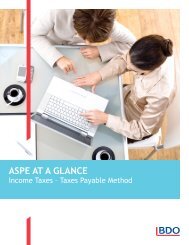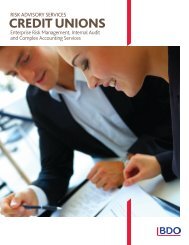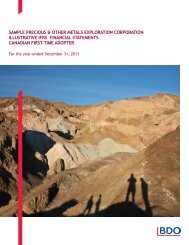Need to Know: IFRS 10 - Consolidated Financial ... - BDO Canada
Need to Know: IFRS 10 - Consolidated Financial ... - BDO Canada
Need to Know: IFRS 10 - Consolidated Financial ... - BDO Canada
- No tags were found...
You also want an ePaper? Increase the reach of your titles
YUMPU automatically turns print PDFs into web optimized ePapers that Google loves.
<strong>IFRS</strong> <strong>10</strong> <strong>Consolidated</strong> <strong>Financial</strong> Statements21Contractual agreements with other vote holders (<strong>IFRS</strong> <strong>10</strong>.B39)A contractual arrangement between an inves<strong>to</strong>r and other vote holders can give the inves<strong>to</strong>r the right <strong>to</strong> exercisevoting rights sufficient <strong>to</strong> give power. An example of this would be the scenario where a contract enables an inves<strong>to</strong>r<strong>to</strong> require enough other vote holders <strong>to</strong> vote in that inves<strong>to</strong>r’s favour when decisions about relevant activities aremade.Another common scenario is where an entity is controlled by its board of direc<strong>to</strong>rs, and the make-up of the board ofdirec<strong>to</strong>rs contractually determined by one specified inves<strong>to</strong>r.Rights from other contractual arrangements (<strong>IFRS</strong> <strong>10</strong>.B40)Other decision-making rights, in combination with voting rights, can give an inves<strong>to</strong>r the current ability <strong>to</strong> direct theinvestee’s relevant activities. For example, rights in a contractual arrangement, when combined with voting rights,may allow an inves<strong>to</strong>r <strong>to</strong> direct operating activities of an investee that significantly affect the investee’s returns.However, an economic dependency of an investee on an inves<strong>to</strong>r (e.g. a relationship between a supplier and its maincus<strong>to</strong>mer) in the absence of any other rights is not sufficient for an inves<strong>to</strong>r <strong>to</strong> have power over an investee.De-fac<strong>to</strong> control<strong>IFRS</strong> <strong>10</strong> explicitly includes the concept of ‘de fac<strong>to</strong>’ control, where an inves<strong>to</strong>r with less than a majority of votingrights has power over an investee. This represents a significant change from IAS 27(2008), and could result indifferent consolidation conclusions for groups that have substantial, but not majority, shareholdings in other entities.The primary focus of the analysis under <strong>IFRS</strong> <strong>10</strong> remains on whether an inves<strong>to</strong>r has sufficient voting rights <strong>to</strong>give that inves<strong>to</strong>r the practical ability <strong>to</strong> direct the relevant activities. This involves an assessment of the size of itsholding of voting rights relative <strong>to</strong> the size and dispersion of holdings of the other vote holders. An inves<strong>to</strong>r thereforeconsiders the following indica<strong>to</strong>rs:––The more voting rights an inves<strong>to</strong>r holds, the more likely the inves<strong>to</strong>r is <strong>to</strong> have existing rights that give it thecurrent ability <strong>to</strong> direct the relevant activities––The more voting rights an inves<strong>to</strong>r holds relative <strong>to</strong> other vote holders, the more likely the inves<strong>to</strong>r is <strong>to</strong> haveexisting rights that give it the current ability <strong>to</strong> direct the relevant activities––The more parties that would need <strong>to</strong> act <strong>to</strong>gether <strong>to</strong> outvote the inves<strong>to</strong>r, the more likely the inves<strong>to</strong>r is <strong>to</strong> haveexisting rights that give it the current ability <strong>to</strong> direct the relevant activities (<strong>IFRS</strong> <strong>10</strong>.B42)––Whether the inves<strong>to</strong>r, other inves<strong>to</strong>rs or other parties hold potential voting rights––The effect of any contractual arrangements––All other facts and circumstances, including voting patterns at previous shareholders’ meetings.Also, the lower the quorum required at the shareholder meeting, the more likely it is that an inves<strong>to</strong>r with asignificant (but still a minority) shareholding will have rights that give it the current ability <strong>to</strong> direct the relevantactivities.There is an important distinction <strong>to</strong> be drawn about voting patterns. <strong>IFRS</strong> <strong>10</strong> makes it clear that the focus is on thenumber of vote holders that have participated in the past and the absolute proportion of voting rights that havehis<strong>to</strong>rically been exercised. It is not on whether other vote holders have voted in the same way as the inves<strong>to</strong>r.If the criteria set out below are met, it may be clear that that the inves<strong>to</strong>r has power over the investee, and no furtheranalysis is needed (also see Example 4 below, which is example 4 in the standard):––Direction of relevant activities is determined by majority vote––The inves<strong>to</strong>r holds significantly more voting rights than any other vote holder or organised group of vote holders––Other shareholdings are widely dispersed (<strong>IFRS</strong> <strong>10</strong>.B43/B44).



